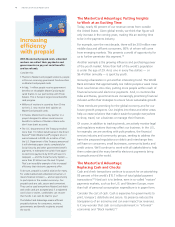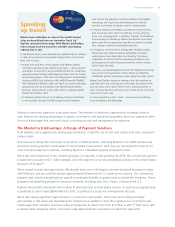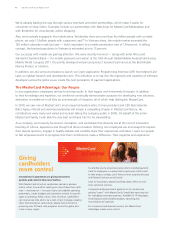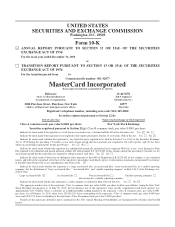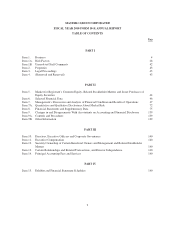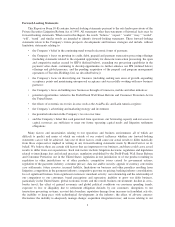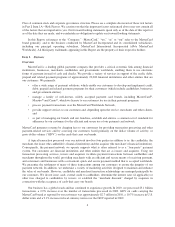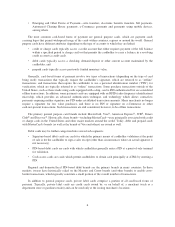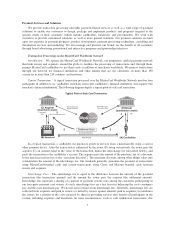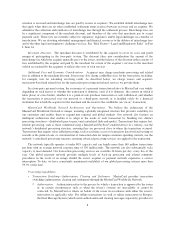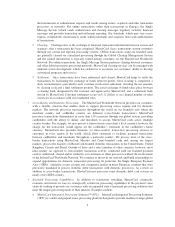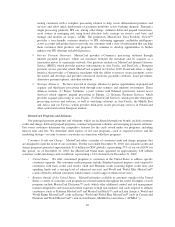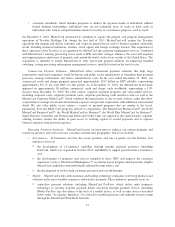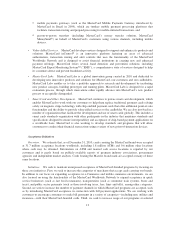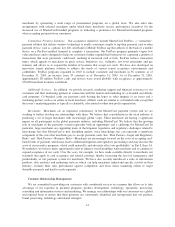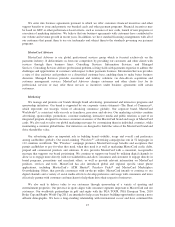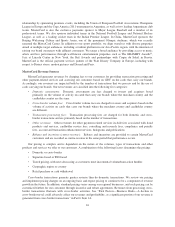MasterCard 2010 Annual Report Download - page 16
Download and view the complete annual report
Please find page 16 of the 2010 MasterCard annual report below. You can navigate through the pages in the report by either clicking on the pages listed below, or by using the keyword search tool below to find specific information within the annual report.• Emerging and Other Forms of Payment—wire transfers, electronic benefits transfers, bill payments,
Automated Clearing House payments, e-Commerce payments and payments using mobile devices,
among others.
The most common card-based forms of payment are general purpose cards, which are payment cards
carrying logos that permit widespread usage of the cards within countries, regions or around the world. General
purpose cards have different attributes depending on the type of accounts to which they are linked:
• credit or charge cards typically access a credit account that either requires payment of the full balance
within a specified period (a charge card) or that permits the cardholder to carry a balance in a revolving
credit account (a credit card);
• debit cards typically access a checking, demand deposit or other current account maintained by the
cardholder; and
• prepaid cards typically access previously funded monetary value.
Generally, card-based forms of payment involve two types of transactions (depending on the type of card
being used): transactions that typically require the cardholder’s signature, which are referred to as “offline”
transactions; and transactions that require the cardholder to use a personal identification number (“PIN”) for
verification, which are typically referred to as “online” transactions. Some purchase transactions outside of the
United States, such as those made using cards equipped with a chip, can be PIN-authenticated but are considered
offline transactions. In addition, some payment cards are equipped with an RFID (radio frequency identification)
microchip, which provides an advanced authentication technique, and technology which allows contactless
payments requiring neither signature nor PIN under established transaction amounts. Many merchants no longer
require a signature for low value purchases, and there is no PIN or signature on e-Commerce or other
card-not-present transactions. Such transactions are still considered, however, to be offline transactions.
The primary general purpose card brands include MasterCard, Visa®, American Express®, JCB®, Diners
Club®and Discover®. Historically, these brands—including MasterCard—were principally associated with credit
or charge cards in the United States and other major markets around the world. Today, debit and prepaid cards
with MasterCard’s brands (as well as the brands of Visa and others) are issued as well.
Debit cards may be further categorized into several sub-segments:
• Signature-based debit cards are cards for which the primary means of cardholder validation at the point
of sale is for the cardholder to sign a sales receipt (other than circumstances where an actual signature is
not necessary).
• PIN-based debit cards are cards with which cardholders generally enter a PIN at a point-of-sale terminal
for validation.
• Cash access cards are cards which permit cardholders to obtain cash principally at ATMs by entering a
PIN.
Regional and domestic/local PIN-based debit brands are the primary brands in many countries. In these
markets, issuers have historically relied on the Maestro and Cirrus brands (and other brands) to enable cross-
border transactions, which typically constitute a small portion of the overall number of transactions.
In addition to general purpose cards, private label cards comprise a portion of all card-based forms of
payment. Typically, private label cards are credit cards issued by, or on behalf of, a merchant (such as a
department store or gasoline retailer) and can be used only at the issuing merchant’s locations.
6


